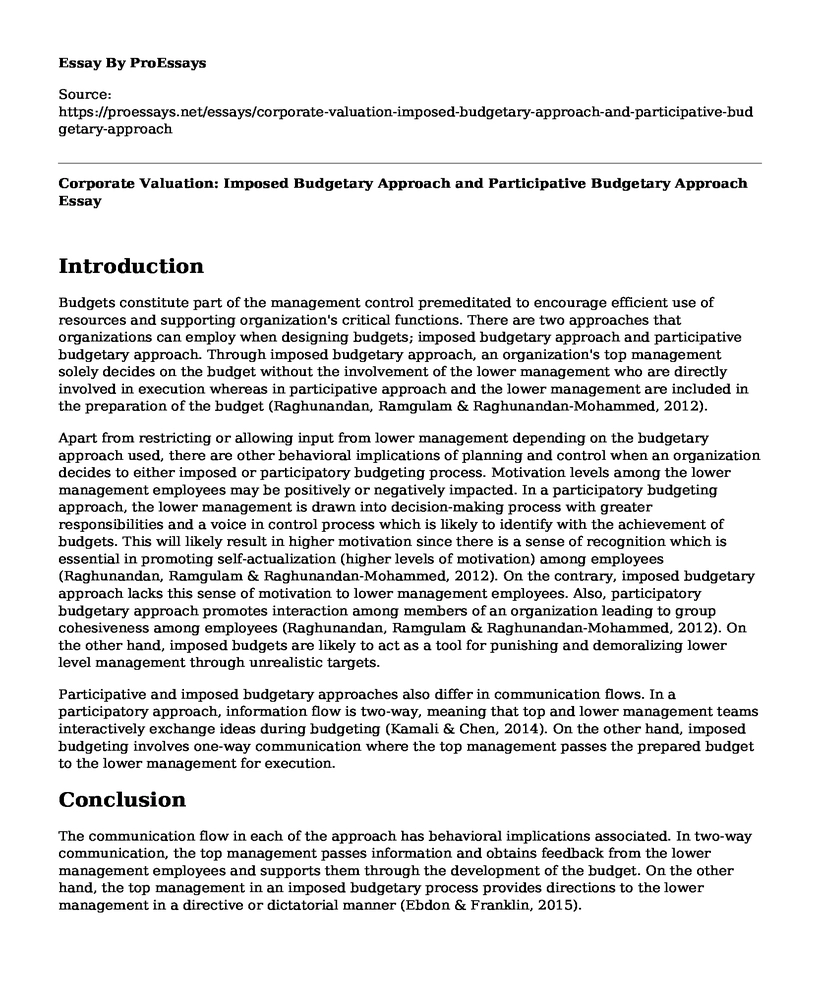Introduction
Budgets constitute part of the management control premeditated to encourage efficient use of resources and supporting organization's critical functions. There are two approaches that organizations can employ when designing budgets; imposed budgetary approach and participative budgetary approach. Through imposed budgetary approach, an organization's top management solely decides on the budget without the involvement of the lower management who are directly involved in execution whereas in participative approach and the lower management are included in the preparation of the budget (Raghunandan, Ramgulam & Raghunandan-Mohammed, 2012).
Apart from restricting or allowing input from lower management depending on the budgetary approach used, there are other behavioral implications of planning and control when an organization decides to either imposed or participatory budgeting process. Motivation levels among the lower management employees may be positively or negatively impacted. In a participatory budgeting approach, the lower management is drawn into decision-making process with greater responsibilities and a voice in control process which is likely to identify with the achievement of budgets. This will likely result in higher motivation since there is a sense of recognition which is essential in promoting self-actualization (higher levels of motivation) among employees (Raghunandan, Ramgulam & Raghunandan-Mohammed, 2012). On the contrary, imposed budgetary approach lacks this sense of motivation to lower management employees. Also, participatory budgetary approach promotes interaction among members of an organization leading to group cohesiveness among employees (Raghunandan, Ramgulam & Raghunandan-Mohammed, 2012). On the other hand, imposed budgets are likely to act as a tool for punishing and demoralizing lower level management through unrealistic targets.
Participative and imposed budgetary approaches also differ in communication flows. In a participatory approach, information flow is two-way, meaning that top and lower management teams interactively exchange ideas during budgeting (Kamali & Chen, 2014). On the other hand, imposed budgeting involves one-way communication where the top management passes the prepared budget to the lower management for execution.
Conclusion
The communication flow in each of the approach has behavioral implications associated. In two-way communication, the top management passes information and obtains feedback from the lower management employees and supports them through the development of the budget. On the other hand, the top management in an imposed budgetary process provides directions to the lower management in a directive or dictatorial manner (Ebdon & Franklin, 2015).
References
Ebdon, C., & Franklin, A. L. (2015). Democracy, public participation, and budgeting: Mutually exclusive or just exhausting?. In Democracy and public administration (pp. 96-118). Routledge.
Kamali, M., & Chen, X. (2014). Internal Communication During the Budgeting Process:-A case study of developing a model for factors affecting internal communications during the budgeting process. Uppsala University.
Raghunandan, M., Ramgulam, N., & Raghunandan-Mohammed, K. (2012). Examining the behavioural aspects of budgeting with particular emphasis on public sector/service budgets. International Journal of Business and Social Science, 3(14).
Cite this page
Corporate Valuation: Imposed Budgetary Approach and Participative Budgetary Approach. (2022, Jun 16). Retrieved from https://proessays.net/essays/corporate-valuation-imposed-budgetary-approach-and-participative-budgetary-approach
If you are the original author of this essay and no longer wish to have it published on the ProEssays website, please click below to request its removal:
- Illustration of Ideal Work Environment Essay
- Essay Sample on Team Effectiveness
- Impact of Conflict and Negotiation on the Organizational Culture of HSBC - Research Paper
- Essay Example on Samaritan's Purse: Effective Leadership Skill for Organization Administration
- Essay Sample on Economic Decision Making: A Vital Skill for All Economics Students
- Essay Example on Differentiation: A Vital Strategy for Market Leadership
- Free Report Example on Rehab Services: Peterson Health Care's Mission







